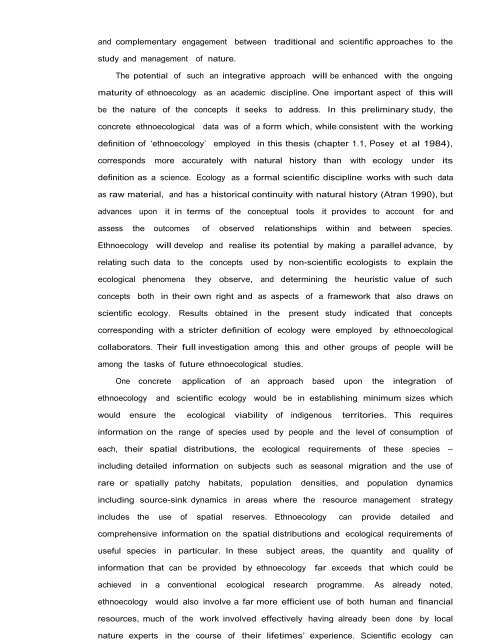Ethnoecology, Resource Use, Conservation And Development In A ...
Ethnoecology, Resource Use, Conservation And Development In A ...
Ethnoecology, Resource Use, Conservation And Development In A ...
Create successful ePaper yourself
Turn your PDF publications into a flip-book with our unique Google optimized e-Paper software.
and complementary engagement between traditional and scientific approaches to the<br />
study and management of nature.<br />
The potential of such an integrative approach will be enhanced with the ongoing<br />
maturity of ethnoecology as an academic discipline. One important aspect of this will<br />
be the nature of the concepts it seeks to address. <strong>In</strong> this preliminary study, the<br />
concrete ethnoecological data was of a form which, while consistent with the working<br />
definition of ‘ethnoecology’ employed in this thesis (chapter 1.1, Posey et al 1984),<br />
corresponds more accurately with natural history than with ecology under its<br />
definition as a science. Ecology as a formal scientific discipline works with such data<br />
as raw material, and has a historical continuity with natural history (Atran 1990), but<br />
advances upon it in terms of the conceptual tools it provides to account for and<br />
assess the outcomes of observed relationships within and between species.<br />
<strong>Ethnoecology</strong> will develop and realise its potential by making a parallel advance, by<br />
relating such data to the concepts used by non-scientific ecologists to explain the<br />
ecological phenomena they observe, and determining the heuristic value of such<br />
concepts both in their own right and as aspects of a framework that also draws on<br />
scientific ecology. Results obtained in the present study indicated that concepts<br />
corresponding with a stricter definition of ecology were employed by ethnoecological<br />
collaborators. Their full investigation among this and other groups of people will be<br />
among the tasks of future ethnoecological studies.<br />
One concrete application of an approach based upon the integration of<br />
ethnoecology and scientific ecology would be in establishing minimum sizes which<br />
would ensure the ecological viability of indigenous territories. This requires<br />
information on the range of species used by people and the level of consumption of<br />
each, their spatial distributions, the ecological requirements of these species –<br />
including detailed information on subjects such as seasonal migration and the use of<br />
rare or spatially patchy habitats, population densities, and population dynamics<br />
including source-sink dynamics in areas where the resource management strategy<br />
includes the use of spatial reserves. <strong>Ethnoecology</strong> can provide detailed and<br />
comprehensive information on the spatial distributions and ecological requirements of<br />
useful species in particular. <strong>In</strong> these subject areas, the quantity and quality of<br />
information that can be provided by ethnoecology far exceeds that which could be<br />
achieved in a conventional ecological research programme. As already noted,<br />
ethnoecology would also involve a far more efficient use of both human and financial<br />
resources, much of the work involved effectively having already been done by local<br />
nature experts in the course of their lifetimes’ experience. Scientific ecology can


